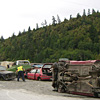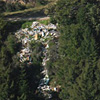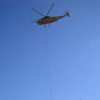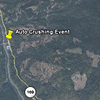Contact Pacific Southwest Waste Program
Pacific Southwest, Region 9
Serving: Arizona, California, Hawaii, Nevada, Pacific Islands, Tribal Nations
Regional Coordination –
Tribes Continue to Work to Improve Waste Management Practices after Major Solid and Hazardous Waste Clean-Ups
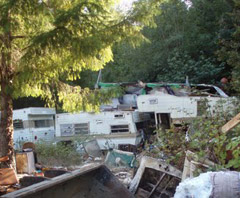
Abandoned vehicles and scattered debris at Tully Creek. (Photo courtesy of CIWMB, 2008)
U.S. EPA Region 9 recently awarded $86,350 in Resource Conservation Fund (RCF) grants to the Yurok and Karuk Tribes in Northern California. The Tribes will use the grant funds to increase material reuse and recycling, and improve solid waste management practices on their lands.
These awards follow large, multi-organization, solid and hazardous waste clean-up efforts that included the Yurok, Hoopa and Karuk Tribes, California Integrated Waste Management Board (CIWMB), U.S. EPA, Indian Health Services (IHS), United Indian Health Services (UIHS), California Rural Indian Health Board (CRIHB) and Humboldt Waste Management Authority.
Efforts to clean up major illegal dumps in the region gained significant momentum in August 2008, when the CIWMB approved $800,000 in funding to clean up three large illegal dump sites on the Yurok Reservation. The dumps posed significant threats to residents of the Yurok Reservation, other Humboldt County citizens and to the Klamath River. The CIWMB approved the project based on commitments from the Yurok Tribe, U.S. EPA and IHS to commit staff time to the project. IHS also contributed an additional $30,000 to fund associated educational outreach efforts and training of a tribal workforce for the project.
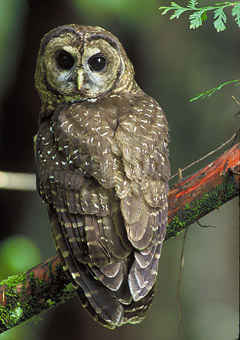
Clean-up activities are delayed until late September when the spotted owl breeding cycle ends. The northern spotted owl was listed as threatened under the Endangered Species Act in 1990. (Photo courtesy of Wikipedia, 2009)
In September 2008, 18 Yurok members were HAZWOPER (Hazardous Waste Operations and Emergency Response) certified to work on sites with hazardous materials. Phase 1 of the dump clean-ups began in October 2008. The sites first addressed were at the end of Tully Creek Road and near Roach Creek within the Klamath Watershed. Challenging terrain required the use of heavy equipment including a Sikorsky helicopter to remove illegally dumped waste from the steep Klamath River gorge.
Over 200 tons of solid and hazardous waste were removed from Tully and Roach Creeks, including tires, appliances, batteries, flammable and toxic solids, and electronic wastes.
During the spring of 2009, a northern spotted owl pair was discovered nesting within 500 feet of the Johnson’s Road illegal dump, the site where the Phase 2 dump clean-ups are scheduled. The clean-up has been delayed until September 2009, after the spotted owl nesting season ends. The Johnson’s Road Dump threatens Mettah Creek. This creek flows directly into the Klamath River which is a federally designated “wild and scenic” river and is critical to salmon habitat.
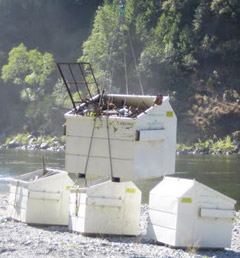
Debris bins were brought in to collect the waste for the helicopter to airlift-out. (Roach Creek, Photo courtesy of CIWMB, 2008)
While waiting to begin the second phase of the dump cleanups, the Yurok Tribe and CIWMB teamed with the Hoopa and Karuk Tribes, U.S. EPA, IHS and Humboldt Waste Management Authority to plan and implement several ancillary projects. In June 2009, the three Tribes coordinated efforts to remove abandoned vehicles from their respective lands. As a result, over 400 vehicles were removed from the Klamath River Watershed. The three Tribes are also planning concurrent household hazardous waste collection events in October 2009. Those projects will be supported through funds provided by the Humboldt Waste Management Authority and U.S. EPA, along with staff support from IHS.
As these clean-up efforts in the region continue, UIHS and CRIHB will assist in coordinating educational and outreach efforts. Residents of the area will be informed of the human health and environmental dangers of illegal dumping as well as safer ways to dispose of and manage their solid waste.
The Yurok, Hoopa and Karuk Tribes have worked for over a decade to address their solid waste issues. Whether working on their own or collaborating with each other, they have been able to acquire funds and services from federal, state, county and Native American organizations. Their efforts over the past few years have significantly reduced the human health and environmental threats caused by illegal dumping of solid and hazardous wastes along the Klamath and Trinity Rivers.
The latest U.S. EPA Region 9 Resource Conservation Fund grants awarded to the Yurok and Karuk Tribes will compliment their recent solid and hazardous waste removal projects by supporting these Tribes’ efforts to reduce illegal dumping, improve solid and hazardous waste management practices and move these communities back toward sustainable waste management practices.
More Photos
